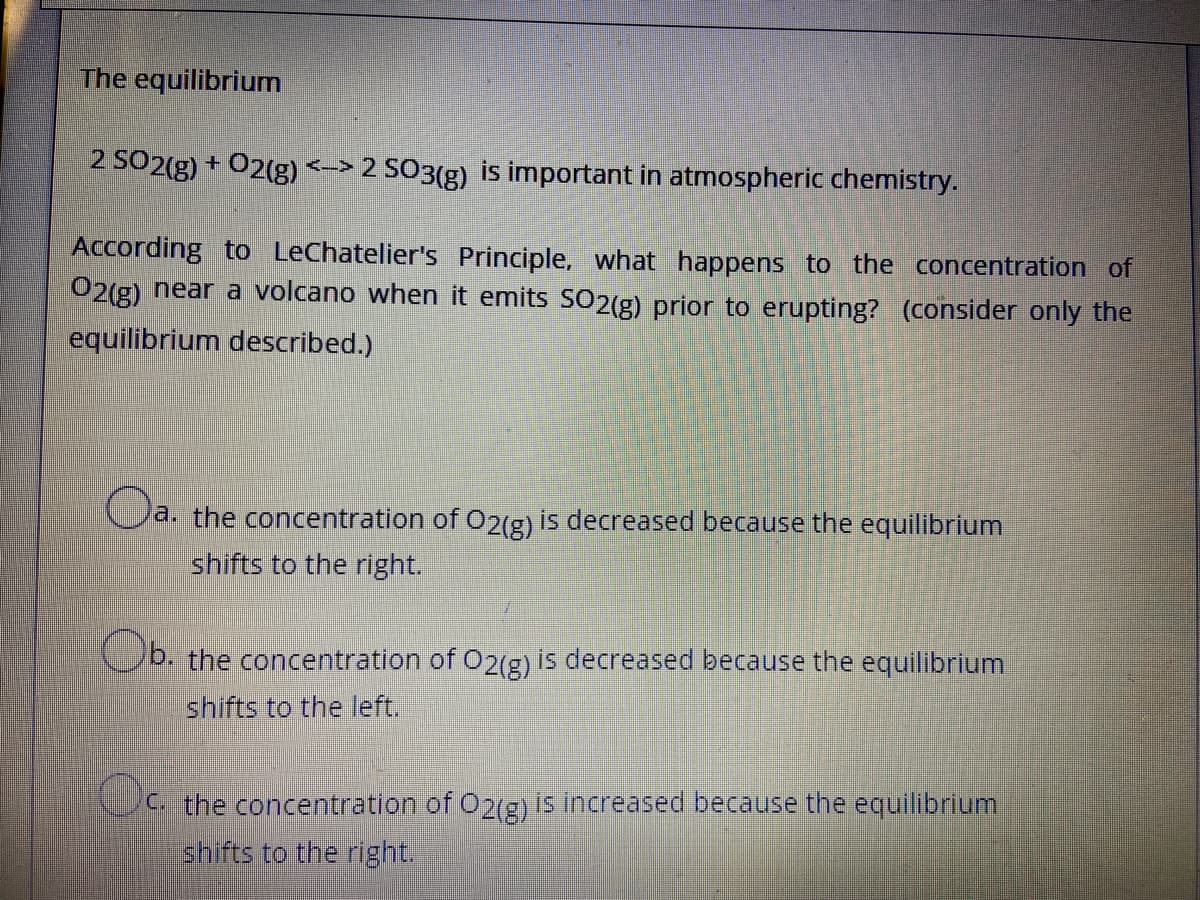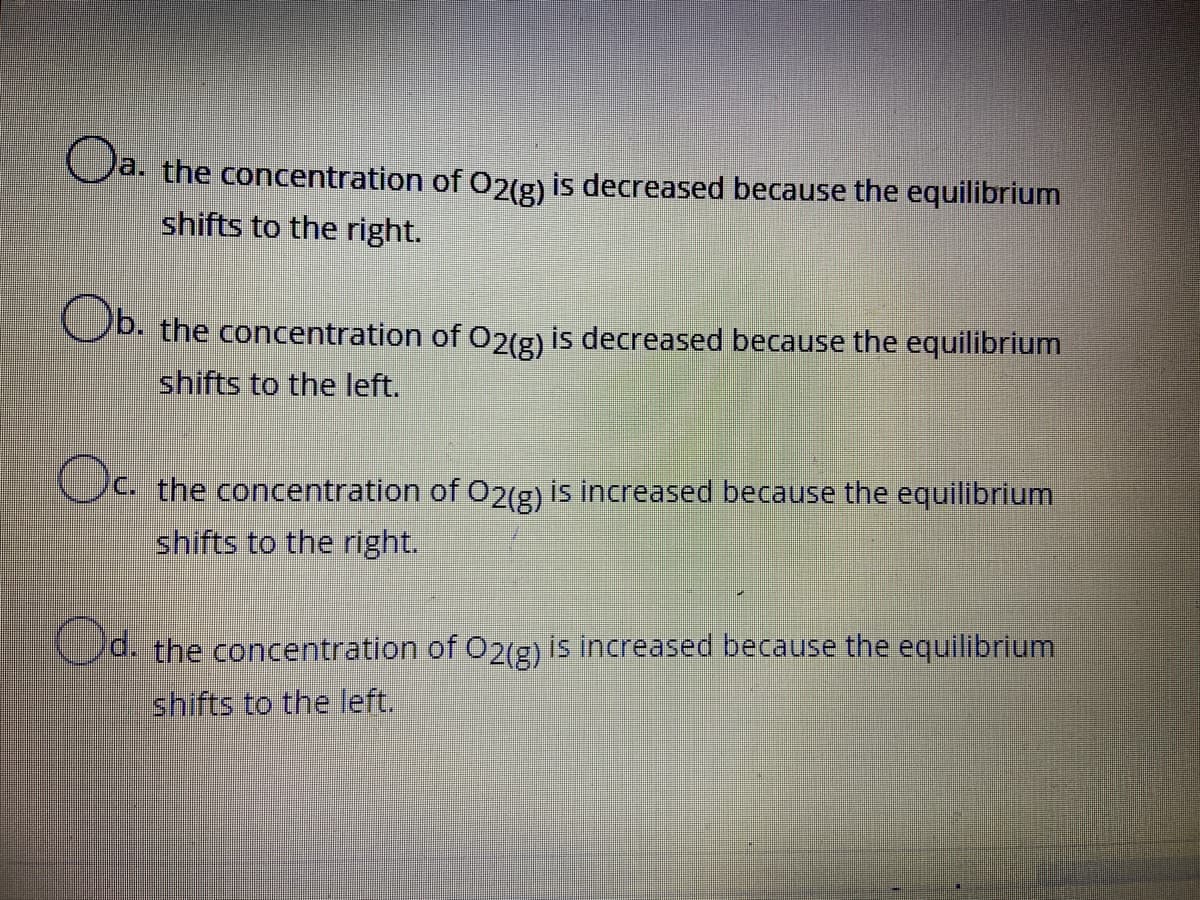The equilibrium 2 SO2(g) + 02(g) <-> 2 SO3(g) is important in atmospheric chemistry. According to LeChatelier's Principle, what happens to the concentration of O2(g) near a volcano when it emits SO2(g) prior to erupting? (consider only the equilibrium described.) a. the concentration of O2(g) is decreased because the equilibrium shifts to the right. Ob. the concentration of O2(g) is decreased because the equilibrium. shifts to the left. C. the concentration of O2(g) is increased because the equilibrium shifts to the right.
The equilibrium 2 SO2(g) + 02(g) <-> 2 SO3(g) is important in atmospheric chemistry. According to LeChatelier's Principle, what happens to the concentration of O2(g) near a volcano when it emits SO2(g) prior to erupting? (consider only the equilibrium described.) a. the concentration of O2(g) is decreased because the equilibrium shifts to the right. Ob. the concentration of O2(g) is decreased because the equilibrium. shifts to the left. C. the concentration of O2(g) is increased because the equilibrium shifts to the right.
Chemistry & Chemical Reactivity
9th Edition
ISBN:9781133949640
Author:John C. Kotz, Paul M. Treichel, John Townsend, David Treichel
Publisher:John C. Kotz, Paul M. Treichel, John Townsend, David Treichel
Chapter15: Principles Of Chemical Reactivity: Equilibria
Section: Chapter Questions
Problem 38GQ: At 2300 K the equilibrium constant for the formation of NO(g) is 1.7 103. N2(g) + O2(g) 2 NO(g)...
Related questions
Question
100%

Transcribed Image Text:The equilibrium
2 SO2(g) + 02(g) <-> 2 SO3(g) is important in atmospheric chemistry.
According to LeChatelier's Principle, what happens to the concentration of
O2(g) near a volcano when it emits SO2(g) prior to erupting? (consider only the
equilibrium described.)
a. the concentration of 02(g) is decreased because the equilibrium
shifts to the right.
b. the concentration of O2(g) is decreased because the equilibrium
shifts to the left.
C the concentration of O2(g) is increased because the equilibrium
shifts to the right.

Transcribed Image Text:Oa.
a. the concentration of O2(g) is decreased because the equilibrium
shifts to the right.
Ob.
Ob. the concentration of 2(g) is decreased because the equilibrium
shifts to the left.
Oc.
C. the concentration of O2(g) is increased because the equilibrium
shifts to the right.
Cd. the concentration of O2(g) is increased because the equilibrium
shifts to the left.
Expert Solution
This question has been solved!
Explore an expertly crafted, step-by-step solution for a thorough understanding of key concepts.
Step by step
Solved in 2 steps with 1 images

Knowledge Booster
Learn more about
Need a deep-dive on the concept behind this application? Look no further. Learn more about this topic, chemistry and related others by exploring similar questions and additional content below.Recommended textbooks for you

Chemistry & Chemical Reactivity
Chemistry
ISBN:
9781133949640
Author:
John C. Kotz, Paul M. Treichel, John Townsend, David Treichel
Publisher:
Cengage Learning

Chemistry & Chemical Reactivity
Chemistry
ISBN:
9781337399074
Author:
John C. Kotz, Paul M. Treichel, John Townsend, David Treichel
Publisher:
Cengage Learning

Chemistry: The Molecular Science
Chemistry
ISBN:
9781285199047
Author:
John W. Moore, Conrad L. Stanitski
Publisher:
Cengage Learning

Chemistry & Chemical Reactivity
Chemistry
ISBN:
9781133949640
Author:
John C. Kotz, Paul M. Treichel, John Townsend, David Treichel
Publisher:
Cengage Learning

Chemistry & Chemical Reactivity
Chemistry
ISBN:
9781337399074
Author:
John C. Kotz, Paul M. Treichel, John Townsend, David Treichel
Publisher:
Cengage Learning

Chemistry: The Molecular Science
Chemistry
ISBN:
9781285199047
Author:
John W. Moore, Conrad L. Stanitski
Publisher:
Cengage Learning

Chemistry for Engineering Students
Chemistry
ISBN:
9781337398909
Author:
Lawrence S. Brown, Tom Holme
Publisher:
Cengage Learning

Chemistry: Principles and Reactions
Chemistry
ISBN:
9781305079373
Author:
William L. Masterton, Cecile N. Hurley
Publisher:
Cengage Learning

Chemistry: Principles and Practice
Chemistry
ISBN:
9780534420123
Author:
Daniel L. Reger, Scott R. Goode, David W. Ball, Edward Mercer
Publisher:
Cengage Learning